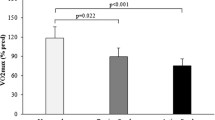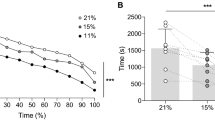Summary
The acute and chronic effects of cigarette smoking on selected physiological responses were determined in seven well-trained non-smokers and seven well-trained habitual smokers. Non-smokers and smokers did not differ significantly with respect to maximal oxygen consumption (\(\dot V_{{\text{O}}_{{\text{2max}}} }\)). The acute effect of smoking two cigarettes immediately prior to a graded exercise stress test on a treadmill ergometer did not significantly alter the \(\dot V_{{\text{O}}_{{\text{2max}}} }\)of either group. However, the time taken for non-smokers to reach exhaustion decreased significantly (F=5.381, P<0.05) by a mean of 0.64 min. Smokers recorded lower scores for forced vital capacity (FVC) and forced expiratory volume in the 1st s exhalation (FEV1) than non-smokers. Only the mean FVC of smokers recorded 5 min post-exercise was significantly altered by pre-exercise smoking. No differences were found between the resting heart rates (HR) of non-smokers and smokers. Smoking two cigarettes significantly (F=44.720, P<0.01) increased the mean resting HR of smokers and non-smokers by 15.8 beats·min−1 and 15.6 beats·min−1 respectively. No alteration to the exercise HR of either group was found under smoking conditions of the \(\dot V_{{\text{O}}_{{\text{2max}}} }\)tests.
Similar content being viewed by others
References
Astrand P-O, Rodahl K (1977) Textbook of work physiology, physiological bases of exercise. 2nd ed: McGraw Hill, p 642
Behr MJ, Leong KH, Jones RH (1981) Acute effects of cigarette smoking on left ventricular function at rest and exercise. Med Sci Sports 13: 9–12
Blackburn H, Brozek J, Taylor HL (1959) Lung volume in smokers and nonsmokers. Ann Int Med 51: 68–77
Backburn H, Brozek J, Taylor HL (1960) Common circulatory measurements in smokers and nonsmokers. Circulation 22: 1112–1124
Brundin T (1980) Effects of tobacco smoking on the blood temperatue during exercise. Acta Physiol Scand [Suppl] 479: 43–47
Burn HJ (1960) Action of nicotine on the heart. Ann NY Acad Sci 90: 70–73
Chevalier RB, Krumholz RA, Ross JC (1966) Reaction of nonsmokers to carbon monoxide inhalation. JAMA 198: 1061–1064
Cooper KH, Grey GO, Bottenberg RA (1968) Effects of cigarette smoking on endurance performance. JAMA 203: 189–192
Drinkwater BL, Raven PB, Horvath SM, Gliner JA, Ruhling RO, Bolduan NW, Taguchi S (1974) Air pollution, exercise and heat stress. Arch Environ Health 28: 177–181
Ekblom B, Goldberg AN (1971) The influence of physical training and other factors on the subjective rating of perceived exertion. Acta Physiol Scand 83: 399–406
Fitch KD, Morton AR (1971) Specificity of exercise in exercise-induced asthma. Br Med J 4: 577–581
Franks BD (1970) Smoking and selected cardiovascular-respiratory measures. Res Q Am Assoc Health Phys Educ 41: 140–144
Goldberg AN, Krone RJ, Resnekov L (1971) Effects of cigarette smoking on hemodynamics at rest and during exercise. 1. normal subjects. Chest 60: 531–536
Juurup A, Muido L (1946) On acute effects of cigarette smoking on oxygen consumption, pulse rate, breathing rate and blood pressure in working organisms. Acta Physiol Scand 11: 48–60
Kay HW, Karpovich PV (1949) Effect of smoking upon recuperation from local muscular fatigue. Res Q Am Assoc Health Phys Educ 20: 250–256
Kerrigan R, Jain AC, Doyle JT (1968) The circulatory response to cigarette smoking at rest and after exercise. Am J Med Sci 225: 113–119
Krumholz RA, Hedrick EC (1972) Exercise response of smoking and nonsmoking middle-aged business executives. J Lab Clin Med 80: 79–87
Maksud MG, Baron A (1980) Physiological responses to exercise in chronic cigarette and marijuana users. Eur J Appl Physiol 43: 127–134
Morton AR, Fitch KD (1974) Sodium cromoglycate BP in the prevention of exercise-induced asthma. Med J Aust 2: 158–162
Rabinowitz BD, Thorp K, Huber GL, Abelmann WH (1979) Acute hemodynamic effects of cigarette smoking in man assessed by systolic time intervals and echocardiography. Circulation 60: 752–759
Raven PB, Drinkwater BL, Ruhling RO, Bolduann U, Taguchi S, Gliner J, Horvath SM (1974) Effect of carbon monoxide and peroxyacetyl nitrate on man's maximal aerobic capacity. J Appl Physiol 36: 288–293
Sagone AL, Lawrence T, Balcerzak SP (1973) Effect of smoking on tissue oxygen supply. Blood 41: 845–851
Seppanen A (1977a) Physical work capacity in relation to carbon monoxide inhalation and tobacco smoking. Ann Clin Res 9: 269–274
Seppanen A (1979b) Comparison of different kinds of tests in the evaluation of lung function among healthy smokers and non smokers. Ann Clin Res 9: 275–280
Winer BJ (1971) Statistical principles in experimental design (2nd ed). McGraw Hill, Kogakusha, pp 191–195
Author information
Authors and Affiliations
Rights and permissions
About this article
Cite this article
Morton, A.R., Holmik, E.V. The effects of cigarette smoking on maximal oxygen consumption and selected physiological responses of elite team sportsmen. Europ. J. Appl. Physiol. 53, 348–352 (1985). https://doi.org/10.1007/BF00422852
Accepted:
Issue Date:
DOI: https://doi.org/10.1007/BF00422852




